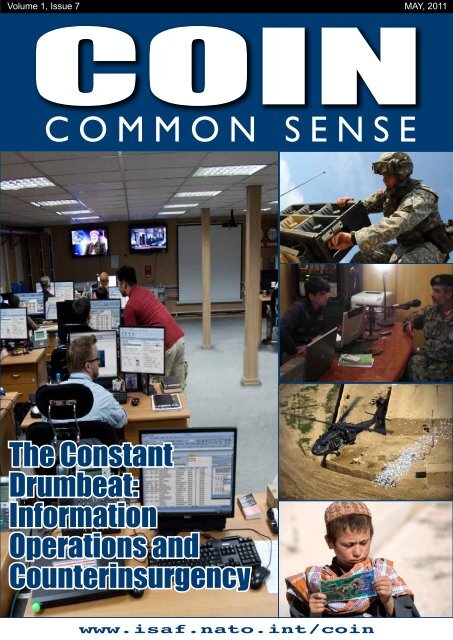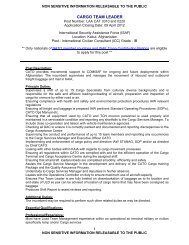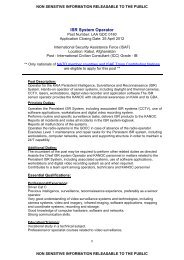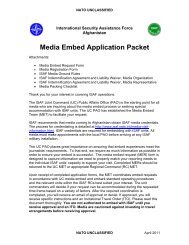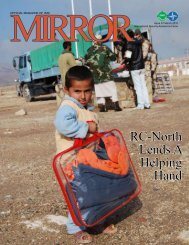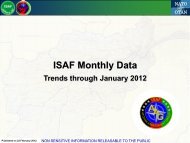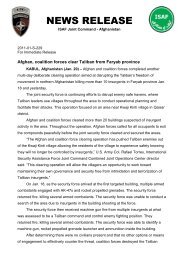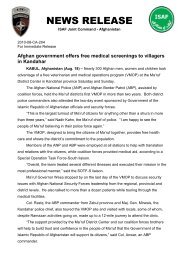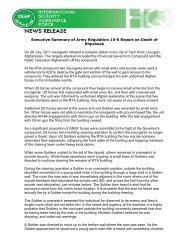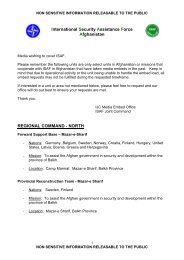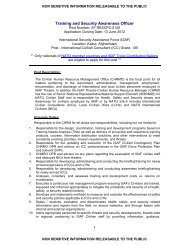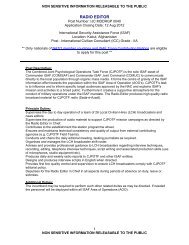COIN Common Sense Vol. 1 Issue 7 - Ronna
COIN Common Sense Vol. 1 Issue 7 - Ronna
COIN Common Sense Vol. 1 Issue 7 - Ronna
- No tags were found...
You also want an ePaper? Increase the reach of your titles
YUMPU automatically turns print PDFs into web optimized ePapers that Google loves.
<strong>Vol</strong>ume 1, <strong>Issue</strong> 7 MAY, 2011<strong>COIN</strong>COMMON SENSEThe ConstantDrumbeat:InformationOperations andCounterinsurgencywww.isaf.nato.int/coin
Executive EditorCSM Marvin HillISAF CSMSenior Managing EditorJohn CurryCAAT Print Media AdvisorContributing EditorJP MorganCAAT IO Advisor<strong>COIN</strong> <strong>Common</strong> <strong>Sense</strong> is written by thetroops, for the troops. We are looking forthe perspectives of everyone playing a rolein the current <strong>COIN</strong> campaign, specificallythose from the front lines (E6 and below,Company Commanders) and from ourAfghan partners. If you have a story youthink we should consider, please send it to:ISAF_<strong>COIN</strong>@swa.army.milSubmission Guidelines:- Articles to be no more than 750 words.- Photos should be high-resolution (300dpi)and no smaller than 3x5.- Please submit photo captions, identifyphotographers, and include a short bio ofthe author (Name, Rank, Unit, Nation)CSM Marvin HillISAF, Command Sergeant MajorFrom the CSMThe level of confidence placed in media is veryhigh in Afghanistan. Media is still consideredthe primary source of reliable information onmost topics. As you know, Afghans seek theirnews from a variety of sources, with word ofmouth being the one you always hear about.The media battle is one of several battlefields that the Coalition and the Talibanare fighting over. The question is, who is winning?From what I’ve seen, the Insurgents are hurting when it comes to competingwith Coalition Information Operations across the theatre. The media landscapein Afghanistan has seen a remarkable growth of over 20% in each of the pastfive years. This corresponds to about 50 new Afghan TV stations and over100 new radio stations since 2006 that often times work with the coalition atthe national level to reach the population. Add that to the national broadcastof CJPOTF’s ‘Radio Bayan’ and the 180 Radio In A Box (RIAB) locationsbroadcasting locally in each Regional Command, and you get a feel of what Iam talking about.Television use is replacing radio use in urbanized areas. As the build phasegains momentum and more Afghans have access to electricity and you see thegradual increase in TV access. The Taliban aren’t purchasing any time on Afghantelevision but their misdeeds are being shown in full living color as oftenas our national-level influence assets can get them out there. This is having thedesired effect as more and more Afghans are speaking out against the Taliban.It also offers the coalition the opportunity to display all the development thatis going on in the country. All total, we are tilting the scales and winning thehearts and minds while building trust in the Afghan government.The radio landscape remains our bread and butter though. When I visit someof the more remote places in RC West and RC Southwest it is clear that ourRIABs have a monopoly on the airways. The population is so removed thatthe only entertainment they get comes from our RIAB broadcasts. The radiois making an even greater impact now that CJPOTF has launched their newPSYOP Radio Network format. They recently changed the name to RadioBayan and now broadcast across the nation in both Dari and Pashtu. Call-inshows reveal that this is catching on quickly.Partnering with the Afghans is also catching on and is indeed the way aheadfor IO in the coming months. It stands to reason that, by including the AfghanNational Army soldiers into the product production phase, we may be able todevelop messaging that resonates instantly with the intended audiences. Earlierit was clear that our production facilities would produce products for wholedistricts without taking into account the need to personalize it to the village andcommunity level. Recent EMBEDs with ANA soldiers and in particular AfghanIO trained soldiers (AIDO) have shown we can make some money in partneredmessaging operations and face to face in the communities with ANA leading.Overall, media is generally viewed by Afghans as a positive force in society,celebrated for addressing key issues – economy, crime, and corruption – and isseen as a way to open minds and educate.<strong>COIN</strong>COMMON SENSEArticlesTheatre Strategic Perspectiveon ISAF IO...........................p3-4Battle for the Airways........p5-6<strong>COIN</strong> Media Applications..p7-8Radio Bayan: “Wave of YourVoice”...............................p9-10STRATCOM Info Ops......p11-12Afghan Information DisseminationOperations...................p12Guardians of Peace............p13Tripartite Information OpsWorking Goup......................p14TRADCOM - Helping AfghanYouth Establish a Voice.......p15Radio in Afghanistan...........p16ExtrasFrom the CSM.................prefaceCOMIJC Tactical InformationDirective...........................p1-2<strong>COIN</strong> <strong>Common</strong> <strong>Sense</strong>Upcoming TopicsInformation Operations<strong>COIN</strong> RefresherGovernance, Development,and CounterinsurgencyEffective <strong>COIN</strong> PracticesEnabling the ANSFRule of Law andCounterinsurgencyFor additional informationon <strong>COIN</strong>, visit our websites at:UNCLASSwww.isaf.nato.int/<strong>COIN</strong>www.YouTube.com/ISAF<strong>COIN</strong>http://afghancoin.harmonieweb.orgMission Secret <strong>COIN</strong> Libraryportal.hq.ms.isaf.nato.int/CGHQ/CAAT/<strong>COIN</strong>default.aspx
HeadquartersISAF Joint CommandKABUL, AFGHANISTANCommander ISAF Joint Command 12 April 2011FOR The Soldiers, Sailors, Airmen and Marines of ISAF JointCommandSUBJECT: COMIJC’s Tactical Information DirectiveThis directive is issued to remind you how critical each servicemembers’contributions are to our mission. Your every interactionwith Afghan partners and the Afghan people affects the perceptionsof our efforts in Afghanistan. You must first understand this, andthen you must take action.The wars of today are unlike any other conflicts in history. Neverhave the actions of individual units and soldiers had the strategicimpact and global visibility they currently have. Technology andmedia have connected the world. Today, the effects of tacticalactions, your actions, are often communicated across villages, districts,provinces, and the world moments after they occur. Thesecommunications, goodor bad, true or false,directly influence theperceptions of everyperson who receivesthem. These perceptionsaffect their beliefsand their behaviors.Therefore, theactions of our strategicprivates, sergeants andcaptains will play keyroles in the outcomeof our efforts in Afghanistan.Your everyaction must be guidedby this awareness.Western culture underestimatesthe power ofthe Afghan “word ofmouth” factor. Giventhe lack in many areasof widespread mediacapability, the word of mouth factor must be understood at thelowest level. Remember, while it is important for the Coalition toconvey information, it is perhaps more important for Afghans to beable to convey accurate information to their countrymen.This directive must be translated into action. It is your responsibility,your duty. You must determine how best to execute it givenyour capabilities. ISAF possesses tremendous capability to assistyou. However, it is impractical to assist every unit during everyoperation; therefore, you must be creative.Information. Information is an element of combat power; it maybe our most powerful weapon. In many areas, the Afghan peoplereceive information about our actions mostly from insurgents. Thismust change. You must rapidly inform the people and our counterparts,provide them facts about operations before, during, and afterthey occur. Tell them the truth. Help them understand that we arehere on their behalf, as their partner, to help them build a better lifefor their families and to build a strong and peaceful Afghanistan.Ensure your words are supported by your actions.Words. People are the decisive terrain. They are who we and ourAfghan partners are fighting for. Communicating and informingthe people is not solely the task of Public Affairs and InformationOperations professionals. Communicating and informing thepeople is now a common Soldier task and an essential element ofbattle command.Authorities. Every tactical commander possesses the authorityto communicate information (facts, data, and instruction) to theAfghan people and our Afghan partners. Understand this and exercisethis authority at every opportunity. Remember, that informationmust be factual, timely, and free from “spin.”Facilitate Afghans communicating with Afghans. A critical partof sending the right message is enabling Afghan leaders to communicatewith the people. Afghans will decide the future of theirnation. They must know the truth about the Taliban, their actionsand their vision for the future. Enabling Afghans to inform theirpeople will lead to more effective communication, credibility andlocal support while reinforcing governmental legitimacy and accountability.Provide accurate information and look for opportunitiesto expand Afghanmedia-reach capabilitiesthrough allavailable resources.Facilitate this actionand partner equally incommunications andoperations.Listen, then speak.Listen to your Afghanhosts and partners.They possess a fargreater understandingof the environmentthan you ever willgain, and they canhelp you to communicatemore effectivelyin your area. Listeningcan often bemore important thanspeaking.Have a Plan. In partnership with Afghan leaders, develop a communicationplan for every operation, lethal or non-lethal, to inform,support decisive action, and achieve complementary effects. Knowthat an overarching Information Operations plan exists for yourarea. Consult your IO officers, understand the capability they haveat their disposal, request talking points and current themes, and integratethem into your engagement strategy. Know the effects youdesire, then request capabilities. Work with your Afghan partners;develop an effective, holistic plan using all available means tomaximize your effects. Build the right team and develop efficientbattle drills to facilitate rapid communication. Assess your actionsand learn what works. Finally, be prepared for those operationsand events that do not turn out as planned. Knowing your audience,required changes in message content, and who should deliverthe message are crucial.Know your area. Every village is different; learn the nuances.Each one requires a different communications plan. Know whatmethods work best in each area and use them to communicate.If you are not sufficiently informed, it will show and it will turnpeople away. Do not assume the people in your area know whyyou are there. Meet with them regularly with your partners and letthem know and answer their questions.Presence, Posture and Profile. Understand that your merepresence can have a significant impact on perceptions of whatwe are all trying to achieve. Limited capability deployed to theright place at the right time can add substantial credibility to themessage. Troop posture on the ground can demonstrate bothcommitment and intent. It can also be inappropriate whereAfghan solutions to Afghan problems are the best approach.Carefully analyze how your troops appear to locals and leverageevery opportunity to send the right message.Enemy. Exploit enemy actions. Communicate those actionsto the people. Inform the populace of the enemy’s actionsthrough both Coalition and ANSF in order to drive a wedge betweenthe insurgents and the population. Synchronize activitiesto defeat enemy media cells and those responsible for generatingand disseminating propaganda; they are as dangerous to ourmission as IEDs. Identify enemy communication methods anddisrupt them.Afghan methods. Understand how Afghans communicatein your area, and then use those channels to communicate.Conduct face-to-face engagements to communicate and buildrelationships with the people. Develop Key Leader phone trees(alert rosters) to rapidly inform Afghan leaders of events. Workwith your Afghan partners to conduct Key Leader Engagementsand encourage Afghans to lead these engagements. If you havea RIAB or similar capability, use it to “be first with the truth.”Use it in conjunction with Afghan leaders to rapidly exploitinsurgent action, inform, and educate people.Remember these points as you conduct your operations. Yourdaily actions and efforts influence the perception and opinionsof those who ultimately will determine victory—the Afghanpeople.In this and future conflicts, rapidly communicating with affectedpopulations will be a key to achievement of objectives.Communicating effectively, through words and deeds, is a taskat which all Soldiers must excel. The way you interact withthe people will be a key factor in whether we and our Afghanpartners earn their support. It is for this reason I ask you toredouble your efforts and execute this directive with vigor.Leaders, this is a commander’s program. We need you to ensureyour Soldiers understand this directive. More importantly,ensure they execute it. Discuss it with them and explain why itis so critical. Discuss vignettes where insurgents exploited ourinability to communicate effectively or timely to their benefit.Discuss the adage, “perception is reality” and its meaning. Discusstechniques that you can integrate into your operations thatenable you to communicate effectively, send the right message,and be “first with the truth.”DAVID M. RODRIGUEZLTG, United States ArmyCommanderISAF Joint Command1 2
ANSF with cache contents Cache Contents Tripartite Information OperationsWorking GroupBy Naina Patel, Mike McDoniel,and Maj. Mark JimisonGuardians of Peace is an Information Operations programthat was developed in October 2010 by Regional CommandEast in order to support the Department of Defenseprogram throughout its region. The campaign is a multimediamarketing and public information campaign rangingfrom broadcasts on TV and radio to billboards andleaflets.Recovery of a Cache in Manjawar, Paktya. This Cachecontained 5x AT Mine, 4x Russian grenade, 1x US grenade,60x AK47 Rds, 388x DSHK Rds,1x 122mm Nose cone, 2xRussian Helmets.By MAJ Christopher Hakes, DCOS COMMThe 4th Tripartite Information Operations WorkingGroup was hosted by The Deputy Chief of Staff,Communication, Headquarters International SecurityAssistance Force (HQ ISAF) in April.The conference was the forth in a series of Tripartitemeetings. The purpose of the meeting is toimprove the co-operation, consultation and commitmentto communication activities between Afghanistan,Pakistan, and ISAF forces.Forty Afghan, Pakistani and ISAF officers attendedthe meeting which included seven General Officers.The Pakistan Military and Afghan NationalArmy principles in attendance, respectively, wereMajor General Athar Abbas, Director General, InterServices Public Relations (ISPR), Pakistan Militaryand Major General Zahir Azimi, the Spokesmanand Chief Parliamentary Public Affairs Officer atthe Afghan Ministry of Defense.An example of one of the posters is below:The pie chart illustration clearly demonstrateshow effective Guardians of the Peace has been.The graph represents weapons cache totals inRC East since June of 2010. As you can see,the impact in the region has been impressive,with over half of all Caches found and cleareddue to Guardians of Peace and the rewardsprograms.These are intended to encourage the Afghan population toreport suspicious or illegal activities and to disclose the locationof munition/weapons caches and IEDs to the ANSF.The aim is to increase the level of securityThere are various ways that the suspicious activity can bereported. Tip lines and call centers have been set up to allowanonymous tips to be made. Cards, handed out by theANSF, can be completed and handed in. There has alsobeen a large increase in tips originating from radio phoneincalls.The program has removed thousands of explosives,munitions, and weapons from the country.This has undoubtedly saved lives but has alsoraised the profile of the ANSF and, in particular,the ANP. Successful operations add to the senseof security, which feeds confidence into thelocal communities, encouraging them to cooperatewith the security forces and to continue toreport any suspicious activity.What is the future for the Guardians of Peaceinitiative? The tentative plan is to “role out”the campaign over the whole of Afghanistan.However, there is one major difference: thenational promotion will not be based purely onthe support of the reward program, althoughthis may still be available. The main emphasisof the scheme going forward will be a focus onhonor and the sense of civic duty motivating thepopulation to report threats to security. But firstwe must get it approved by GEN Karimi.This was originally started by GEN Stanley Mc-Crystal a little over a year ago. The idea is that aconstant dialogue will improve mutual understandingand unity of effort when operating within theinformation environment, especially in the regionsaffected by the border between Afghanistan andPakistan. The conference focused on a range ofsubjects including the transition process, springoperations, counter narcotics and the problems ofammonium nitrate fertilizer in the production ofIEDs. Each subject was discussed in the context ofimproving the joint communication effort to addresseach issue.To date, each of the tripartite engagements hasgenerated promising dialogue between delegationsand remains an important ingredient in getting theinputs right in the wider <strong>COIN</strong> strategy. The PakistanMilitary will host the fifth Tripartite InformationOperations Working Group this summer inPakistan.13 14
TRADCOM - Helping Afghan Youth Establish a VoiceLt Col Kelly Brown, TRADCOM ChiefWhat is TRADCOM?Afghanistan has a diverse population that speaks four primarylanguages (Dari, Pashtu, Uzbeck, and Turkmen) and 30 minorlanguages. This diversity presents a unique challenge to theimplementation of influence and outreach efforts. Coupledwith that is Afghanistan’s extremely high illiteracy rate – only28% of the population is literate. When you combine that withvarying trust and availability of conventional communicationmodes, such as TV and radio, you get a glimpse of theobstacles we face with our standard influence and outreachtechniques.To counter these limitations, ISAF’s Deputy Chief of Staff forCommunication (DCOS COMM) and his Director of Influenceand Outreach are exploiting Afghanistan’s more traditional,“word-of-mouth” and “person-to-person”, communicationpractices. DCOS COMM’s Traditional Communication(TRADCOM) Branch is a unique blend of about five militarypersonnel usually seen in traditional Afghan dress. Thisteam specializes in the engagement of the Afghan communitythrough culturally-established, word-of-mouth networks.TRADCOM conducts influence and outreach operationsthroughout Afghanistan in both formal and informal settings- such as shuras and jirgas - by partnering with populationcentricministries in order to influence key audiences andpopulations, such as tribal elders, religious leaders, youth, andwomen. For the purposes of this article we will focus on theAfghan Youth.Afghanistan YouthYouth in Afghanistan is defined as boys and girls aged 14-30.Although this group accounts for approximately 70% of Afghanistan’stotal population, the “youth” have been consciouslyexcluded from the decision making process for the past 30years by a system that strictly values age as a sign of maturityand decision making capability. This long-term disenfranchisement,and systematic dismissal, has left Afghanistan’syouth frustrated with current processes, disillusioned with thegovernment, distanced from the elders, and in search of a15voice. With few alternatives available, Afghan youth repeatedlyturn to the insurgency for an outlet and sense of inclusion.Embracing the Afghan youth in decision making processes,from the village to the national level, is strategically importantfor a number of reasons:• Youth that are accepted by and involved in communitydecision making processes do not seek out the insurgencyfor an outlet or sense of inclusion.• With a life expectancy rate of 44 years, today’s Youth willbe running Afghanistan at all levels in the next 5-7 years.Involving them in decision making processes early willafford Afghan’s future leaders the opportunity to developcritical thinking skills and become familiar with associatedchallenges and limitations of politics, communityrelations, and essential service distribution.Keys to TRADCOM Success/Lessons Learned:• Understand the environment – perceptions, needs,and influence triggers vary throughout the country• Identify traditional systems and work within them• “Shoulder to shoulder” means operating in thesame environment and under the same conditionsas our Afghan partners - do not set or employdouble standards• When executing strategic partnerships, be willingto accept increased levels of calculated personalrisk• Be creative and use your imagination – influenceand outreach is not a cookie cutter business• Listen to your target audience• Blend with the environment – wearing Afghanclothing, beards for men, and scarves for womenshows respect, garners instant credibility, andopens doors• Operate in and among the population – insightsgained from face to face visits cannot be achievedwith the same depth via other modesEstablishing a VoiceThrough its partnership with the Minister of Information andCulture and his Deputy Minister of Youth Affairs (DMoYA),TRADCOM has facilitated the establishment of Afghanistan’sfirst-ever National Youth General Assembly and ProvincialYouth Shuras across the nation. Modeled on the premise ofrepresentative democracy, the intent of the national and provinciallevel organizations is the establishment of an apoliticalbody by Afghan youth for Afghan youth. Also known asHigh Youth Councils, the Provincial Youth Shuras are used asvenues to reaffirm the importance of volunteerism, communityservice, and entrepreneurship, as well as give Afghan youtha formalized system through which to identify problems andrecommend solutions.In order to establish the Provincial Youth Shuras, TRADCOMassisted the Ministry in developing a strategy, coordinatingcoalition support, and partnering with an NGO to facilitatelocal logistics and garner US Embassy funding support.By executing an extremely aggressive program,the TRADCOM-DMoYA partnership team will establishYouth shuras in 100% of Afghanistan in less than sixmonths.Way AheadAfghanistan will hold its second National Youth GeneralAssembly in July 2011. The focus of this event willbe review and ratification of a national Youth WorkingPlan. The DMoYA will present the Youth Working Planto Parliament and the President of Afghanistan there byofficially establishing the link between the Youth andformally established decision making processes. Additionally,Afghanistan’s first Youth Expo designed tospecifically address the Youth’s primary concerns – lackof qualified educators and educational opportunities,unemployment, and rampant narcotics influences – willkick-off during the July General Assembly.Radios inAfghanistanBy Maj Owen Coulman, USMC& Russ Hampsey, CAAT IO AdvisorAnyone who has been in Afghanistan over the past fewyears has likely heard of the Radio in a Box, or morecommonly called, the RIAB. RIABs have become themust-have accessory for just about every unit conductingInformation Operations. Why are they so popular? Inshort, their portability, scalability, and customizability arecritical to getting the right message to the right people atthe right time. There are literally an infinite number of possibleconfigurations of power output, level of automation,range, etc. You can set up your own WKRP in Cincinnatior ‘Pirate Radio’ channel here in Afghanistan.Getting High Tech with Satellite LinksRecently, the capability potential of the RIAB has growneven greater with the arrival of the VSAT, or Very SmallAperture Terminal. This allows the battlespace owner toLINK his RIABs via satellite internet connectivity, allowingfor a whole network of radio stations, each broadcastingthe same message; much like Rush Limbaugh’s Excellencein Broadcasting Network or The John Boy and BillyShow, where you can find the broadcast anywhere in theUnited States during showtimes. The individual RIABs canalso be disconnected from the network in order to deliverregion-specific broadcasts, interviews, or special programming.The key element that VSAT provides is the abilityto instantaneously message across the entire network fromone site without having to disseminate product to the outstationsseparately.PartneringIf you really want to see these radios used at maximum effect– incorporate the ANA and local national DJs into themix. The Information Operations department in RC Easthas broken the code on partnering and has local nationalsworking at each of their 78 RIABs within the command.The ANA cultural and religious officers help with programmingin some cases. Often times the district sub-governorsand police chiefs record their messages on discs that are inturn played over the RIABs to their constituents.The RIAB in Nerkh conducts interactive programming.Meaning they run live “call-in shows” and actually urge theTaliban to call in and give their views. This offers us theopportunity to engage in counter-propaganda banter withthem as well as put them on the sport for recent atrocitiesthey committed. It is also an impact indicator that they arelistening to our show, allowing us to directly target themwith messages on the air using our local national DJs.No one knows the local national population like the Afghans.The folks in RC East have realized this and are providingthe way ahead. The CAAT team will try to shop outthis SOP to the other RCs with their best practices and shortcuts so we don’t encounter the same obstacles and speed upthe process. Partnering with the Afghans will indeed set theconditions for transition in the IO Arena.16
<strong>COIN</strong>What does <strong>COIN</strong> look like to you?Send us your photos and if they’re goodenough we’ll publish them here. Sendphotos to ISAF_CAAT@AFGHAN.SWA.ARMY.MIL


